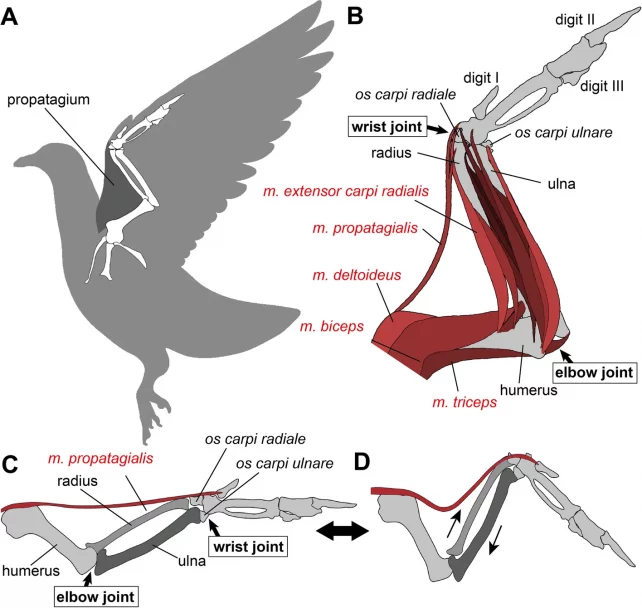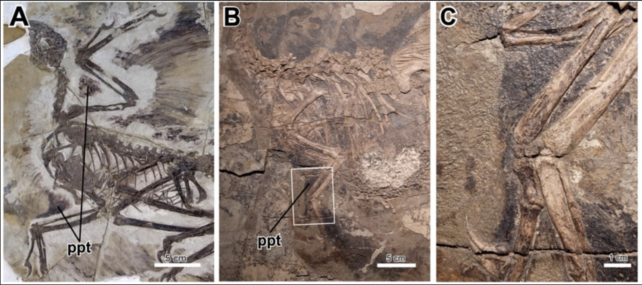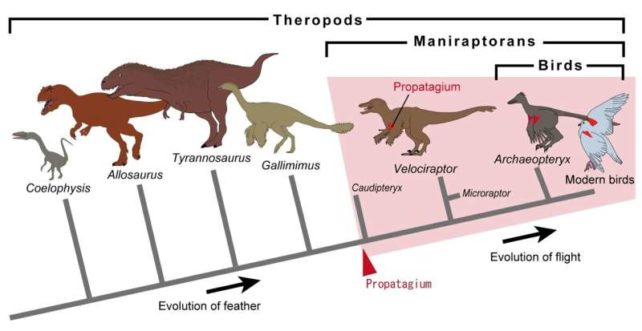Dinosaur fossils, featuring arms with a suspect bend at the elbow and wrist, could hint at an unpreserved tendon that underpins all modern avian flight.
If researchers at the University of Tokyo are right, that posture could provide clues on the pathway that Earth's flying vertebrates followed to take to the skies.
The evolution of wings powerful enough to lift a vertebrate off the ground is one of the greatest mysteries in paleontology.
Pterosaurs are famous for being the earliest known vertebrates to achieve true lift-off nearly 200 million years ago. Yet these massive ancient reptiles weren't dinosaurs, leaving the direct ancestors of birds to figure out the whole flying business all on their own.
Avian dinosaurs would only evolve much later from two-footed, feathered theropods – 80 million years or more after pterosaurs had already achieved powered flight.
Despite these vastly different origin stories, birds use a strikingly similar structure to pterosaurs to stay aloft, one that, like feathers, seems to have evolved long before flight itself.
Called a propatagium, it's a membrane present in all living vertebrates that flap their wings today, including birds and bats. Some gliding mammals even have a similar structure present across their parachute-like upper limbs.
The best way to imagine a propatagium is to stick your arm out to the side with a bent elbow and wrist. Now picture a tendon stretching from your shoulder across to your hand, creating a bridge, or the 'leading edge' of a wing.
This 'bridge' allows flying birds to flex and extend their wrist and elbow in unison during a flapping motion. The structure essentially gives lift to a bird's flight, allowing the animal to control two joints at once.

For pterosaurs, its role is less clear, but the propatagium seems to have controlled flight take-off and landing by altering the flow of air over the wing's upper surface.
Without the tendon present, some scientists think birds, bats, and dinosaurs might never have gotten off the ground.
"It's not found in other vertebrates, and it's also found to have disappeared or lost its function in flightless birds, one of the reasons we know it's essential for flight," explains paleontologist Tatsuya Hirasawa from the University of Tokyo.
"So, in order to understand how flight evolved in birds, we must know how the propatagium evolved."
The problem is, the propatagium is a soft tissue, which means it's rarely preserved in the fossil record. What's more, this tendon is so thin, it doesn't leave much of a mark on the bones it attaches to.
Thankfully, Hirasawa and his colleague, Yurika Uno, have figured out a way to 'see' the tendon, even when it's no longer there. The clue is to know how the propatagium restricts an animal's movements.
When a modern bird dies, for instance, this membrane naturally keeps the animal's wrist and elbow in flexion.
Comparing the conspicuous angle of the elbow to the bend of arms in non-avian theropod fossils, researchers have found evidence that a propatagium-like structure probably stretched across the shoulder and wrist of several terrestrial dinosaurs.
For instance, the angles observed in the fossils of many 'maniraptorans' (which includes velociraptors) were slightly larger than those seen in modern birds, but they still hinted at the presence of an early propatagium-like structure.

To back up these predictions, researchers also identified soft tissue remnants of what may be an early propatagium in two maniraptoran fossils: the turkey-sized Caudipteryx and the four-winged microraptor.
The Caudipteryx probably couldn't fly, and it's still disputed whether the microraptor could. Yet both of these dinosaurs clearly possessed the structures that would later become necessary for powered flight.

Velociraptors are another maniraptoran that probably couldn't fly, but further research will be needed to see if their fossils hold clues of a long-lost propatagium.
Based on the recent results, however, researchers at the University of Tokyo think the propatagium may be ancestral to all maniraptorans, a lineage that stretches back roughly 150 million years.

The only exception is the contentious Archaeopteryx, which is difficult to place on the dinosaur tree but may or may not be considered a maniraptoran. Whether the famous feathered dinosaur could even fly is hotly debated, with some speculating the animal used its limbs to simply glide.
The angle of its wrist and elbow in fossils certainly doesn't suggest it had a propatagium-like structure.
"Therefore," the authors of the new research write, "Archaeopteryx was probably incapable of executing the kinematics of modern avian powered flight."
Maybe if Archaeopteryx had had a propatagium, its ancestors would still be flying today.
The study was published in Zoological Letters.
